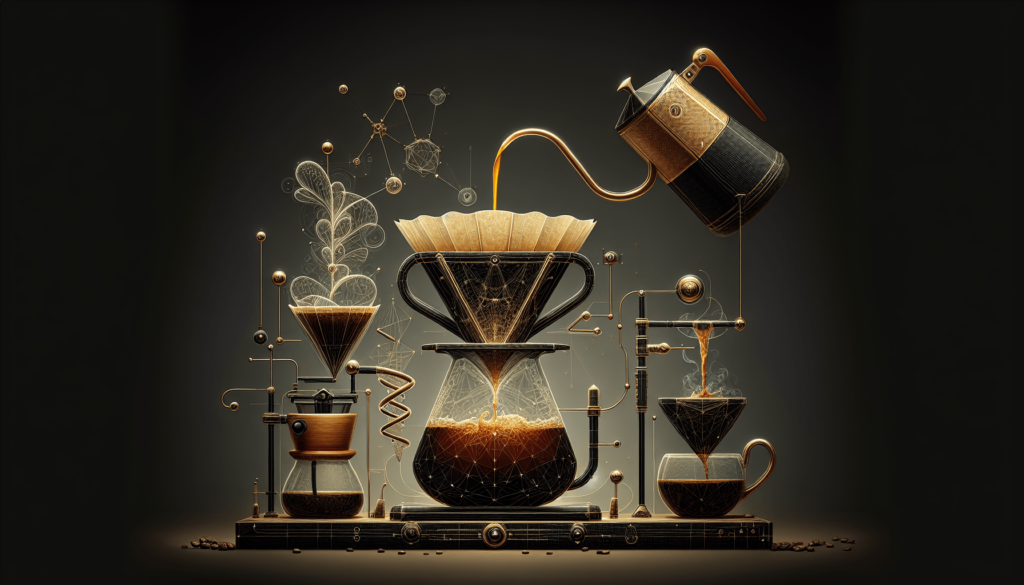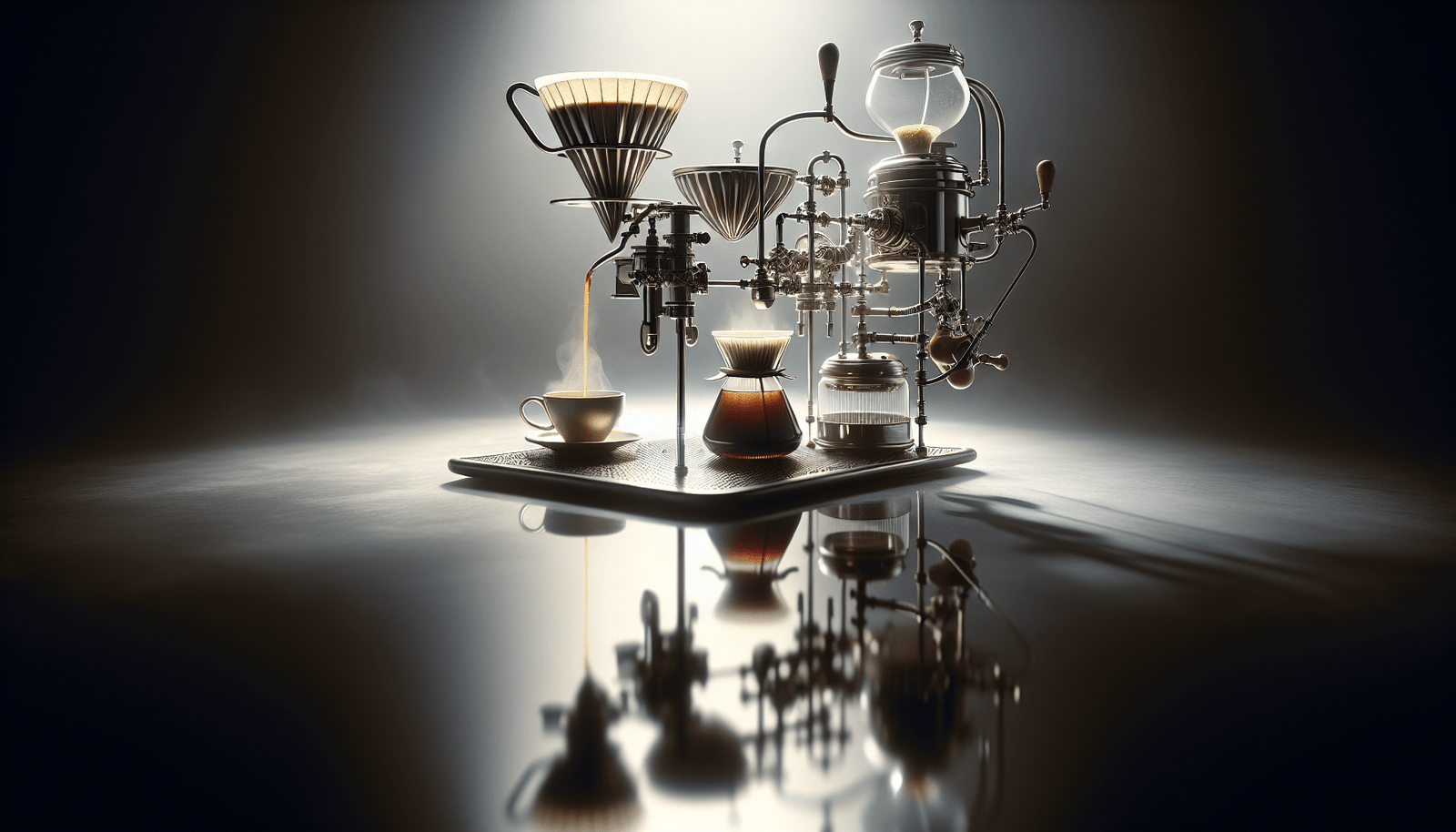Have you ever wondered about the magic that happens when you brew a cup of coffee? The Science Behind Coffee Brewing: Extraction and Equipment takes you on a journey into the fascinating world of coffee making. From understanding the extraction process to exploring the different brewing equipment, this article will unveil the science behind that perfect cup of joe that you savor every morning. Get ready to dive into the intricate details and discover the secrets to unlocking the full potential of your coffee beans.
Coffee Extraction
Extraction Process
The extraction process is a crucial step in brewing a delicious cup of coffee. It involves the dissolution of soluble compounds from the coffee grounds into the water, creating the flavors and aromas that we love. The extraction process is influenced by various factors, including grind size, water temperature, and brew time.
Solubles in Coffee
Coffee contains a variety of solubles, which are the compounds that dissolve in water during the extraction process. These solubles include acids, sugars, oils, and bitter compounds. Each of these solubles contributes to the complex flavors and characteristics of the coffee. Finding the right balance between these solubles is essential for achieving a well-extracted cup.
Extraction Factors
Several factors affect the extraction process, and understanding them can help you brew better coffee. The coffee-to-water ratio determines the strength of your coffee, while the grind size affects the surface area of the coffee particles that come into contact with water. Water temperature plays a critical role in extracting specific flavors, and brew time influences the extraction yield.
Brewing Equipment
Coffee Beans
Choosing the right coffee beans is the first step in brewing a great cup of coffee. The origin and variety of the beans can significantly impact the flavor profile. Different regions produce coffee beans with distinct characteristics, ranging from fruity and floral to earthy and chocolatey. Experimenting with different beans can open up a world of flavor possibilities.
Grinding
Grinding your coffee beans just before brewing ensures optimal extraction. The grind size determines the rate at which the coffee’s flavors are extracted. Finer grinds result in quicker extraction, while coarser grinds require a longer brew time. Investing in a high-quality grinder allows you to achieve consistency and control over the grind size.
Water
Water is a vital element in coffee brewing, accounting for a significant percentage of the final cup. The composition of water can affect the extraction process and the overall taste of the coffee. Using filtered water or water with a balanced mineral content is recommended to avoid any unpleasant flavors. Additionally, water temperature plays a crucial role, with most experts recommending a range of 195°F to 205°F for optimal extraction.
Brewing Methods
There are various brewing methods available, each offering unique characteristics and flavor profiles. Drip brewing is a popular method that involves passing water through coffee grounds in a filter. Espresso is a concentrated and intense brewing method that uses high pressure to extract coffee flavors. The French press offers a full-bodied and rich cup of coffee by steeping coffee grounds in water and then separating them with a mesh plunger. The Aeropress is a versatile method that allows for experimentation and customization.

The Extraction Process
Introduction
The extraction process is vital in determining the flavor and strength of your coffee. It involves the transfer of soluble compounds from the coffee grounds into the water, creating the taste and aroma we associate with a good cup of coffee. Understanding the key concepts of extraction yield and balance can help you brew coffee to your desired taste.
Extraction Yield
Extraction yield refers to the percentage of coffee solids that are dissolved and extracted during the brewing process. It is usually measured by conducting a coffee-to-water mass ratio. A higher extraction yield generally results in a stronger and more flavorful cup of coffee. However, it is essential to strike a balance and avoid over-extraction, which can lead to bitterness.
Extraction Balance
Achieving a well-balanced extraction is crucial to creating a harmonious cup of coffee. Balance refers to the ratio and interaction of different solubles in the coffee. Too much extraction of bitter compounds can overpower the flavors and result in an unpleasant taste. Similarly, an under-extracted coffee can taste weak and lack complexity. Experimenting with different brewing parameters allows you to find the perfect balance that suits your preferences.
Solubles in Coffee
Coffee Components
Coffee is made up of various components that contribute to its flavor and aroma. Acids provide brightness and liveliness, sugars offer sweetness, oils contribute to the mouthfeel, and bitter compounds add complexity. The interaction and balance of these components determine the overall taste of your coffee. Exploring different coffee beans and brewing methods can help you discover the range of flavors hidden within each cup.
Taste and Aroma
The solubles in coffee directly impact the taste and aroma of the final brew. Acids bring fruity or acidic notes, sugars provide sweetness, oils add body and richness, and bitter compounds contribute to complexity. The combination of these flavors creates a unique sensory experience. Different brewing methods and extraction factors can emphasize or diminish certain flavors, allowing you to customize the taste and aroma to your liking.

Extraction Factors
Coffee-to-Water Ratio
The coffee-to-water ratio plays a crucial role in the extraction process. It determines how strong or weak your coffee will be. Adjusting the ratio allows you to control the extraction yield and tailor the strength of your brew. Generally, a ratio of 1:15 (1 part coffee to 15 parts water) is considered a good starting point.
Grind Size
Grind size affects the surface area of the coffee particles, directly influencing the extraction process. Finer grinds offer a larger surface area and faster extraction, while coarser grinds require more time for the water to fully extract the flavors. Experimenting with different grind sizes can help you find the ideal extraction time for your preferred brewing method.
Water Temperature
Water temperature has a significant impact on the extraction process. Optimal water temperature allows for proper extraction of flavors without scorching the coffee. Most experts and coffee enthusiasts recommend a temperature range between 195°F and 205°F (90°C to 96°C) for best results. Consistently monitoring and adjusting the water temperature can help you achieve a well-balanced and flavorful cup of coffee.
Brew Time
Brew time refers to the duration of coffee and water contact during the extraction process. It determines how much flavor is extracted from the coffee grounds. Longer brew times tend to increase extraction yield, resulting in a stronger and more intense cup. However, excessive brew time can lead to over-extraction and bitterness. Experimenting with different brew times allows you to find the perfect balance for your desired taste.
Coffee Beans
Origin and Varieties
The origin and variety of coffee beans have a significant impact on the flavor and characteristics of the final cup. Different regions, such as Colombia, Ethiopia, and Brazil, offer unique profiles, influenced by factors such as soil, climate, and altitude. Similarly, different coffee varieties, such as Arabica and Robusta, possess distinct flavor profiles. Exploring the diverse world of coffee origins and varieties can enrich your coffee drinking experience.
Roasting
Roasting is a crucial step in coffee bean preparation. It brings out the flavors, aroma, and overall characteristics of the beans. Lighter roasts generally highlight the unique flavors and characteristics of the origin, while darker roasts offer bolder tastes with notes of caramelization. Finding the right roast level that complements your preferred flavor profile can enhance your coffee brewing experience.
Freshness
Freshness is key when it comes to coffee beans. After roasting, coffee beans start to release carbon dioxide, making them more susceptible to oxidation and flavor degradation. It is best to purchase whole beans and grind them just before brewing to preserve freshness. Storing beans in an airtight container away from sunlight and excessive moisture can help maintain their flavor for longer. Experimenting with different roast dates and assessing the flavor changes over time can add an extra layer of enjoyment to your coffee experience.
Grinding
Impact of Grind Size
Grind size directly affects the extraction rate and overall flavor profile of your coffee. A finer grind exposes a larger surface area, allowing for quicker and more efficient extraction. On the other hand, a coarser grind requires a longer brew time to extract the desired flavors. Finding the optimal grind size for your brewing method ensures proper extraction and a well-balanced cup of coffee.
Grinder Types
Investing in a high-quality grinder is essential for achieving consistent and precise grind sizes. There are two main types of grinders: blade and burr grinders. Blade grinders use rotating blades to chop the coffee beans, resulting in uneven particle sizes. Burr grinders, on the other hand, crush the beans between two burrs, offering a more uniform grind. Burr grinders are generally recommended for achieving better extraction and flavor consistency.
Water
Water Composition
The composition of water used in coffee brewing can significantly impact the taste and extraction process. Ideally, using filtered water or water with a balanced mineral content is recommended. Water with high mineral content can result in off-flavors, while distilled water may result in a dull and flat-tasting coffee. Experimenting with different water sources and treatments can help you find the perfect water composition for your preferred flavor profile.
Water Temperature
Water temperature is a critical factor in coffee extraction. Water that is too hot can over-extract the flavors and turn the coffee bitter, while water that is too cold may result in under-extraction and weak flavors. Maintaining the water temperature within the range of 195°F to 205°F (90°C to 96°C) is generally considered optimal for achieving a well-balanced and flavorful cup of coffee.
Brewing Methods
Drip Brewing
Drip brewing is a popular and widely-used method for brewing coffee. It involves pouring hot water over coffee grounds placed in a filter. The water percolates through the grounds, extracting flavors and oils, and drips into a pot or cup. Drip brewing offers a straightforward and convenient brewing process, allowing for consistent results.
Espresso
Espresso is a concentrated and intense brewing method that uses high pressure to extract coffee flavors. It involves forcing hot water through finely ground coffee, resulting in a small, concentrated shot of espresso. The high pressure contributes to the extraction of rich flavors and a characteristic layer of crema. Espresso is the foundation of many popular coffee beverages such as cappuccinos and lattes.
French Press
The French press is a popular brewing method that offers a full-bodied and rich cup of coffee. It involves steeping coarsely ground coffee in hot water for several minutes, followed by pressing a mesh plunger to separate the grounds from the liquid. French press brewing allows for direct contact between coffee and water, resulting in a robust and flavorful brew.
Aeropress
The Aeropress is a versatile brewing method that has gained popularity among coffee enthusiasts. It combines elements of immersion brewing and pressure extraction. The coffee and water are mixed together in a chamber, and then gentle pressure is applied to extract the flavors. The Aeropress allows for experimentation and customization, allowing you to brew coffee to your desired strength and flavor profile.
Conclusion
Understanding the science behind coffee extraction and the role of brewing equipment is essential for brewing a delicious cup of coffee. Factors such as grind size, water temperature, and brew time contribute to the extraction process, while the choice of coffee beans and brewing method determines the final flavors and characteristics. With experimentation and attention to detail, you can unlock the full potential of your coffee brewing experience and enjoy a personalized cup of joe that suits your taste preferences. So grab your favorite brewing equipment, select your preferred beans, and embark on a journey of discovery and enjoyment as you explore the world of coffee extraction and the equipment that brings it to life.

